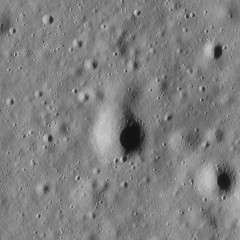Earthlight (crater)
 Apollo 15 panoramic camera image | |
| Coordinates | 26°04′N 3°39′E / 26.06°N 3.65°ECoordinates: 26°04′N 3°39′E / 26.06°N 3.65°E |
|---|---|
| Diameter | 210 m[1] |
| Eponym | Astronaut-named feature |
Earthlight is a feature on Earth's Moon, a crater in the Hadley–Apennine region. Astronauts David Scott and James Irwin drove past it on their rover in 1971, on the Apollo 15 mission, during EVA 2.
Earthlight is located about 1.5 km east of Hadley Rille, less than 1 km north of the larger Dune crater, and about 2 km south of the Apollo 15 landing site itself, at Last crater.
The crater is subdued and not obvious on the surface, and the astronauts did not stop to observe it. During the drive towards Mons Hadley Delta, Jim Irwin said, "I can just barely see the western slope of Earthlight. But the southern slope of it, I can also see, has several blocks on it."[2]
The crater was named by the astronauts after the novel by Arthur C. Clarke (which takes place in and around Mare Imbrium on the moon), and the name was formally adopted by the IAU in 1973.[1] Clarke was delighted to receive a three-dimensional map of the landing site signed and sent by the Apollo 15 crew, two decades after the novel was written.[3]
References
- 1 2 Earthlight, Gazetteer of Planetary Nomenclature, International Astronomical Union (IAU) Working Group for Planetary System Nomenclature (WGPSN)
- ↑ Traverse to Station 6 on Mt. Hadley Delta, Apollo 15 Lunar Surface Journal, Corrected Transcript and Commentary Copyright 1996 by Eric M. Jones
- ↑ Foreword to The Space Trilogy (including The Sands of Mars, Earthlight, and Islands in the Sky) by Arthur C. Clarke, 2001.
External links
- Apollo 15 Traverses, Lunar Photomap 41B4S4(25)